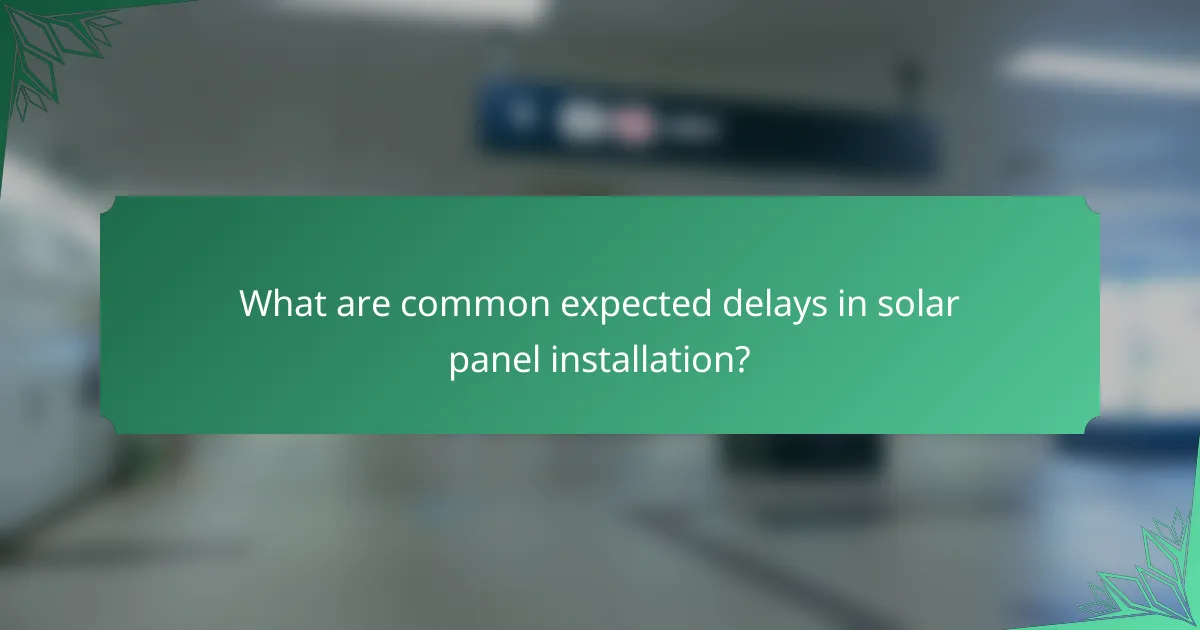
What is the Solar Panel Installation Timeline?
The solar panel installation timeline typically spans four to six months from initial consultation to system activation. The process begins with a site assessment, which usually takes one to two weeks. Following this, the design phase occurs, taking an additional two to four weeks. Permitting can add another two to six weeks, depending on local regulations. Once permits are approved, installation generally takes one to three days. After installation, inspections may require one to two weeks. Finally, the system is connected to the grid, which can take an additional week. Delays can occur due to permitting issues, weather conditions, or equipment availability.
How long does the solar panel installation process typically take?
The solar panel installation process typically takes one to three days. This duration can vary based on the size of the system and the complexity of the installation. A standard residential installation may take about one day. Larger systems or those requiring additional structural work may extend to three days. Factors such as permitting and inspections can also influence the timeline. Generally, homeowners should anticipate a seamless process if all preparations are in place.
What are the stages involved in the installation timeline?
The stages involved in the solar panel installation timeline include site assessment, design, permitting, installation, inspection, and interconnection. The site assessment evaluates the location for solar potential. This is followed by the design phase, where the system layout is created. Next, permitting involves obtaining necessary approvals from local authorities. The installation stage includes mounting panels and connecting electrical components. After installation, an inspection ensures compliance with regulations. Finally, interconnection connects the system to the grid, allowing for energy production. Each stage is essential for a successful solar panel installation.
What factors influence the duration of each stage?
The duration of each stage in solar panel installation is influenced by several factors. These factors include site assessment complexity, permitting processes, equipment availability, and weather conditions. The complexity of the site can affect how quickly installation can proceed. Permitting processes vary by location and can introduce delays. Equipment availability is crucial, as delays in receiving solar panels or inverters can extend the timeline. Weather conditions, such as rain or snow, can also halt work and prolong each stage. Each of these factors plays a significant role in determining how long the installation process will take.
What are the key phases of solar panel installation?
The key phases of solar panel installation include site assessment, design, permitting, installation, and inspection. During the site assessment, professionals evaluate the location for solar panel viability. This phase ensures optimal sunlight exposure and identifies any potential obstacles. The design phase involves creating a customized solar system layout based on the assessment. Next, the permitting phase secures necessary approvals from local authorities. Installation follows, where the solar panels and associated equipment are physically mounted. Finally, the inspection phase verifies that the installation meets all regulations and functions correctly. Each phase is critical for a successful solar panel installation.
What happens during the initial consultation phase?
During the initial consultation phase, a solar installation expert assesses the homeowner’s energy needs. The expert reviews the property’s roof and orientation for solar panel suitability. They discuss the homeowner’s goals and expectations for solar energy. The consultation includes an analysis of local regulations and incentives. The expert provides preliminary cost estimates based on the assessment. Homeowners receive information on financing options available for installation. This phase establishes a foundation for the project’s next steps. Accurate energy consumption data is crucial for optimizing system size.
How does the design phase contribute to the overall timeline?
The design phase is crucial as it sets the foundation for the solar panel installation timeline. This phase involves creating detailed plans and specifications, which directly influence subsequent phases. Delays in the design phase can lead to a cascading effect on the overall project timeline. Accurate designs prevent issues during installation, reducing the need for revisions. According to the National Renewable Energy Laboratory, a well-planned design can shorten the installation phase by up to 20%. Efficient design processes streamline approvals and procurement, further enhancing timeline adherence.
What occurs during the permitting phase?
During the permitting phase, necessary approvals for solar panel installation are obtained. This phase involves submitting applications to local authorities. The applications include project details, site plans, and compliance with zoning regulations. Authorities review the applications for safety and environmental impact. The duration of this phase can vary based on location and complexity. Delays may occur due to incomplete documentation or additional requirements. Once approved, permits are issued, allowing construction to proceed. This phase is crucial for ensuring legal compliance and project viability.
What activities are involved in the installation phase?
The installation phase involves several critical activities. These activities include site assessment and preparation. Technicians evaluate the roof or ground area for suitability. They then install mounting systems to secure solar panels. Next, solar panels are positioned and connected to the mounting systems. Electrical wiring is installed to connect panels to the inverter. The inverter is then set up to convert solar energy into usable electricity. Finally, a system check ensures everything functions correctly. Each step is essential for a successful solar panel installation.
How is the inspection phase conducted?
The inspection phase is conducted by evaluating the solar panel installation for compliance with local codes and regulations. Inspectors assess the installation’s structural integrity and safety measures. They verify that the electrical systems are correctly installed and functioning. Inspections typically occur at various stages, including before, during, and after installation. Inspectors may check equipment specifications against permits. The process ensures that the installation meets safety standards and operational efficiency. Compliance with these standards is crucial for system performance and warranty validation.

What are common expected delays in solar panel installation?
Common expected delays in solar panel installation include permitting issues, weather conditions, and equipment availability. Permitting delays can occur due to local regulations and required inspections. Weather conditions, such as rain or snow, can halt outdoor work. Equipment availability may be affected by supply chain disruptions. Additionally, installation crew scheduling conflicts can lead to further delays. These factors collectively contribute to an extended timeline for solar panel installation projects.
What factors can cause delays in the installation timeline?
Delays in the installation timeline can occur due to various factors. Weather conditions, such as heavy rain or snow, can halt progress. Permit delays can arise from local government processing times. Supply chain issues can lead to shortages of necessary materials. Labor availability can affect scheduling, especially if skilled workers are in high demand. Site preparation challenges, like unexpected structural issues, can also cause setbacks. Changes in project scope requested by the client can lead to additional delays. Each of these factors can significantly impact the overall timeline for solar panel installation.
How do weather conditions impact the installation schedule?
Weather conditions significantly impact the installation schedule of solar panels. Rain, snow, or extreme temperatures can delay outdoor work. For example, rain can create unsafe conditions for electrical installations. Snow accumulation can obstruct access to sites and equipment. High winds can pose risks during the lifting and placement of panels. According to the National Renewable Energy Laboratory, adverse weather can extend project timelines by several days to weeks. Planning for weather variations is essential to maintain safety and efficiency during installations.
What role do permitting and inspections play in potential delays?
Permitting and inspections are critical factors that can cause delays in solar panel installation. The permitting process requires obtaining necessary approvals from local authorities. This process can take several weeks or even months, depending on jurisdiction. Inspections are mandatory to ensure compliance with safety and building codes. Scheduling these inspections can lead to further delays if inspectors are unavailable. Delays in permitting and inspections can push back the entire installation timeline. In many cases, projects experience a backlog due to high demand for permits. Consequently, timely completion of solar panel installations can be significantly impacted.
How can supply chain issues affect installation timelines?
Supply chain issues can significantly delay installation timelines for solar panel projects. These delays often occur due to shortages of essential components, such as solar panels, inverters, and mounting systems. When manufacturers face disruptions, they cannot deliver products on schedule. This results in postponed installation dates as contractors wait for necessary materials.
For instance, a report from the Solar Energy Industries Association noted that supply chain constraints led to an average project delay of 2-4 months in 2022. Additionally, logistical challenges, such as transportation delays, can further exacerbate the situation. Consequently, projects may experience extended timelines, impacting overall project costs and customer satisfaction.
What can homeowners do to mitigate delays in solar panel installation?
Homeowners can mitigate delays in solar panel installation by preparing all necessary documentation in advance. This includes permits, financing agreements, and contracts with installers. Homeowners should also choose a reputable solar installation company with a proven track record. Researching and reading customer reviews can help in this selection process. Additionally, homeowners should ensure their roofs are in good condition before installation. Addressing any structural issues can prevent delays during the installation phase. Communicating clearly with the installation team about timelines and expectations is also crucial. Regular follow-ups can keep the project on track. Lastly, homeowners should be aware of local regulations that may affect installation timelines. Understanding these can help avoid unexpected delays.
What are best practices for selecting a solar installation company?
Research reputable solar installation companies. Look for those with strong customer reviews and ratings. Verify their experience in solar installations. Companies should have a proven track record of successful projects. Check their certifications and licenses. A qualified installer must adhere to local regulations. Request multiple quotes to compare pricing and services. This helps ensure competitive rates and transparency. Inquire about warranties and maintenance services. A reliable company offers robust support post-installation. Review their financing options. Flexible payment plans can make solar more accessible.
How can proper planning and communication help avoid delays?
Proper planning and communication are essential for avoiding delays in solar panel installation. Effective planning involves creating a detailed timeline that outlines each phase of the installation process. This timeline helps identify potential bottlenecks and allocate resources efficiently. Clear communication among all stakeholders ensures that everyone is aware of their responsibilities and deadlines. When teams communicate regularly, they can address issues promptly before they escalate. According to a study by the Project Management Institute, projects with effective communication are 20% more likely to be completed on time. Therefore, proper planning and communication significantly reduce the risk of delays in solar panel installation.

How can one prepare for solar panel installation?
To prepare for solar panel installation, homeowners should first assess their energy needs. Understanding energy consumption helps determine the appropriate system size. Next, they should evaluate their roof’s condition and orientation. A structurally sound and optimally oriented roof maximizes solar efficiency. Homeowners must also check local regulations and permits required for installation. Compliance with local laws ensures a smooth installation process. Additionally, obtaining multiple quotes from solar providers aids in choosing the best option. Comparing costs and services can lead to better decisions. Finally, securing financing options may be necessary for the investment. Knowing available incentives and financing can reduce overall costs.
What steps should be taken before the installation starts?
Before the installation of solar panels begins, several essential steps must be taken. First, a site assessment should be conducted to evaluate the location’s suitability for solar energy. This includes checking roof orientation, shading, and structural integrity. Second, obtaining necessary permits is crucial, as local regulations often require specific approvals for solar installations. Third, selecting a qualified solar contractor is important to ensure proper installation and compliance with standards. Fourth, reviewing financing options can help determine the budget and available incentives. Finally, scheduling the installation date with the contractor ensures that all preparations are aligned. These steps are vital for a successful solar panel installation process.
How can homeowners assess their property for solar panel suitability?
Homeowners can assess their property for solar panel suitability by evaluating several key factors. First, they should check the roof’s orientation and angle. South-facing roofs typically receive the most sunlight. Next, homeowners must inspect for shading from trees or buildings. Significant shade can reduce solar panel efficiency. Additionally, they should assess the roof’s structural integrity. A strong, stable roof is essential for supporting solar panels. Homeowners should also consider local climate conditions. Regions with more sunlight are generally more suitable for solar energy. Finally, they can consult with solar installation professionals. Experts can provide detailed assessments based on specific property characteristics.
What documentation is needed prior to installation?
Prior to solar panel installation, several key documents are required. These documents include a signed contract with the installation company. Additionally, a permit from the local jurisdiction is often necessary. This permit ensures compliance with local building codes. Proof of property ownership is typically needed as well. Utility company interconnection agreements may also be required. Finally, any necessary inspections should be documented. These documents facilitate a smooth installation process and ensure all regulations are met.
What are the final considerations for a successful solar panel installation?
Final considerations for a successful solar panel installation include assessing the structural integrity of the roof. A stable roof can support the weight of solar panels and withstand environmental factors. Additionally, evaluating the orientation and angle of the roof maximizes sunlight exposure. This can significantly enhance energy production.
Permitting and local regulations must also be reviewed. Compliance with these regulations ensures legal installation and avoids potential fines. It is essential to choose high-quality materials and components for durability and efficiency. Quality equipment can lead to better performance and longer lifespan.
Lastly, hiring experienced professionals for installation is crucial. Skilled installers can ensure proper setup and connection to the electrical system. This reduces the risk of issues post-installation and optimizes system performance.
How can homeowners ensure they are ready for the installation day?
Homeowners can ensure they are ready for the installation day by preparing their property in advance. This includes clearing the installation area of any obstructions. Homeowners should also ensure that access to the roof is unobstructed for the installation team. Confirming that all necessary permits are in place is crucial, as delays can occur without them. Homeowners should communicate with the installation company about the schedule and any specific requirements. Additionally, reviewing the contract and installation details ahead of time can prevent misunderstandings. Having a designated point of contact on the installation day can streamline communication. Finally, homeowners should plan for any potential disruptions, such as temporary power outages during the installation process.
What should be expected during the final inspection and activation?
During the final inspection and activation of solar panel systems, several key elements should be expected. Inspectors will evaluate the installation for compliance with local codes and regulations. They will check the structural integrity of the mounting system. Inspectors will also verify the electrical connections and ensure proper grounding.
The system’s performance will be tested to confirm it meets specified output levels. Inspectors may review documentation, including permits and warranties. Once approved, the system will be activated and connected to the grid. Homeowners should receive instructions on monitoring system performance post-activation. This process typically ensures the solar system operates efficiently and safely.
The main entity of this article is the solar panel installation timeline, which encompasses the phases and potential delays associated with the installation process. The article outlines a typical timeline that spans four to six months, detailing each stage from site assessment to system activation. It highlights key phases such as design, permitting, and installation, while also addressing factors that may cause delays, including permitting issues, weather conditions, and supply chain disruptions. Homeowners are provided with actionable insights on how to prepare for installation and mitigate potential delays, ensuring a smoother transition to solar energy.